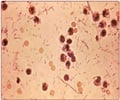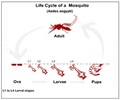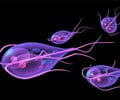Information about the Malarial Parasite - PLASMODIUM
Endo-erythrocytic cycle or Schizogony cycle:
- The tissue phase plasmodium enters into the Red cells and develops into a trophozoite.
- From the trophozoite numerous merozoites are liberated into the blood stream.
- Each merozoite liberated attacks Red blood cells and continuous independent cycle and multiplication.
- The liberation of merozoite corresponds to clinical symptoms of shivering and fever in a malaria patient.
Life cycle in the Mosquito
The life cycle in mosquito is called as sexual cycle or sporogony cycle.
- When blood is fed by Anopheles mosquito from a malaria patient, the plasmodium enters the stomach of the mosquito.
- The plasmodium develops into gametes or germ cells, which fuse to form Syngamy, which results in the formation of zygote or egg cell.
- The egg develops into sporozoites which are motile and enters the salivary gland of the mosquito and in this stage the mosquito is called as infective mosquito, which is ready to transmit the infection
- When the infected mosquito bites a human host, the sporozoites enter the blood stream to form Tissue phase and the life cycle is continued.
- In the human body, the malarial parasite shows asexual development and therefore man is the intermediate host. Inside the female anopheles mosquito the parasite shows sexual development and hence mosquito is definitive host.














